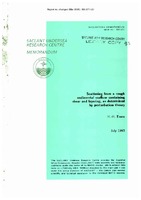| dc.contributor.author | Essen, Heinz-Hermann | |
| dc.date.accessioned | 2018-10-11T14:06:16Z | |
| dc.date.available | 2018-10-11T14:06:16Z | |
| dc.date.issued | 1993/07 | |
| dc.identifier | 1754 | |
| dc.identifier.govdoc | SM-271 | |
| dc.identifier.uri | http://hdl.handle.net/20.500.12489/220 | |
| dc.description.abstract | First-order perturbation theory is applied to reverberation from a rough sedimental seafloor. In addition to existing approaches, the seafloor is allowed to be shear-supporting or to be layered. Scattering strengths are derived for both monostatic and bistatic reverberation, and compared with results from a non-layered fluid bottom. By exceeding some 350 ms-1, shearwave velocity significantly influences scattering strength for angles below the critical angle of total reflection. Layering, as modelled by a two-layer fluid seafloor, mainly influences scattering at grazing angles just above critical. | |
| dc.format | vi, 21 p. : ill. ; 21 fig. | |
| dc.language | English | |
| dc.publisher | NATO. SACLANTCEN | |
| dc.subject | Acoustic scattering - Seafloor and sea surface | |
| dc.subject | Perturbation (Mathematics) | |
| dc.subject | Acoustic reverberation | |
| dc.subject | Shear waves | |
| dc.title | Scattering from a rough sedimental seafloor containing shear and layering, as determined by perturbation theory | |
| dc.type | Scientific Memorandum (SM) | |
